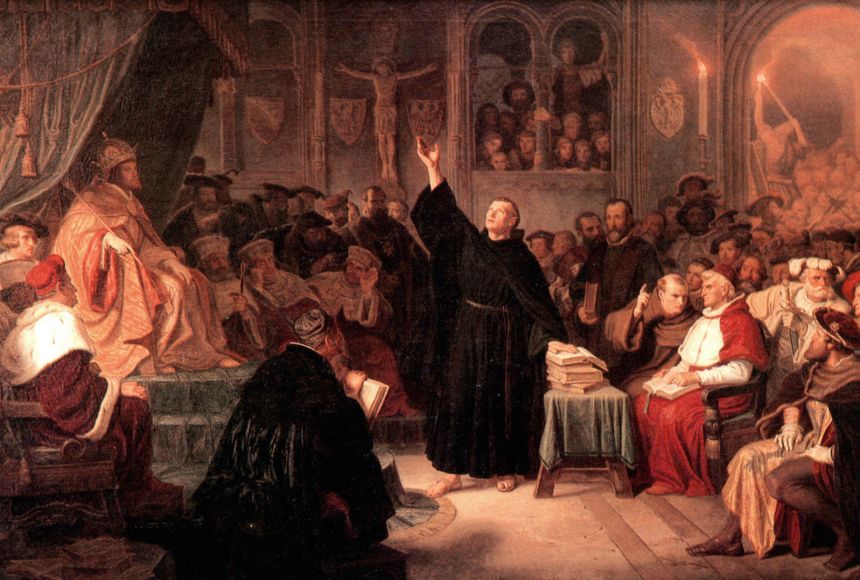The Protestant Reformation was a religious reform movement that swept through Europe in the 1500s. It resulted in the creation of a branch of Christianity called Protestantism, a name used collectively to refer to the many religious groups that separated from the Roman Catholic Church due to differences in doctrine.
The Protestant Reformation began in Wittenberg, Germany, on October 31, 1517, when Martin Luther, a teacher and a monk, published a document he called Disputation on the Power of Indulgences, or 95 Theses. The document was a series of 95 ideas about Christianity that he invited people to debate with him. These ideas were controversial because they directly contradicted the Catholic Church's teachings.
Luther's statements challenged the Catholic Church's role as intermediary between people and God, specifically when it came to the indulgence system, which in part allowed people to purchase a certificate of pardon for the punishment of their sins. Luther argued against the practice of buying or earning forgiveness, believing instead that salvation is a gift God gives to those who have faith.
Luther's objections to the indulgence system paved the way for other challenges to the Catholic doctrine throughout Europe. For example, John Calvin in France and Huldrych Zwingli in Switzerland proposed new ideas about the practice of Holy Communion, and a group called Anabaptists rejected the idea that infants should be baptized in favor of the notion that baptism was reserved for adult Christians.
Broadly speaking, most of the challenges to the Catholic Church revolved around the notion that individual believers should be less dependent on the Catholic Church, and its pope and priests, for spiritual guidance and salvation. Instead, Protestants believed people should be independent in their relationship with God, taking personal responsibility for their faith and referring directly to the Bible, the Christian holy book, for spiritual wisdom.
Protestant reform in England began with Henry VIII in 1534 because the Pope would not grant him a marriage annulment. Subsequently, King Henry rejected the Pope's authority, instead creating and assuming authority over the Church of England, a sort of hybrid church that combined some Catholic doctrine and some Protestant ideals. Over the next 20 years, there was religious turbulence in England as Queen Mary (1553–1558) reinstated Catholicism in England while persecuting and exiling Protestants, only to have Queen Elizabeth I and her Parliament attempt to lead the country back toward Protestantism during her reign (1558–1603).
Some English citizens did not believe Queen Elizabeth's efforts to restore England to Protestantism went far enough. These citizens fell into two groups, both labeled Puritans by their opponents. The first group, known as separatists, believed the Church of England was so corrupt that their only choice was to leave England, separate from the church, and start a new church. They called this the English Separatist Church.
Around 1607 or 1609, some of the separatists tried to start the new lives they imagined in Holland, in the Netherlands. Ultimately, the endeavor failed due to poverty and the sense that the children were assimilating too much into Dutch culture, so many of the separatists returned to England.
By 1620, members of the English Separatist Church were ready for a second try at establishing a new life and church. Those who set sail aboard the Mayflower for New England and eventually landed near Plymouth, Massachusetts, would, in time, become known as the Pilgrims.
The other group of English citizens who did not believe Queen Elizabeth's reform efforts went far enough were called nonseparatists; over time, the term "Puritan" would become synonymous with the nonseparatists. They did not seek to leave the Church of England; they wanted only to reform it by eliminating the remnants of Catholicism that remained. In terms of theology, most of them were Calvinists.
Although they did not desire to separate from the Church of England, some Puritans saw emigrating to New England as their best chance at true reform of the church and freedom to worship as they chose. In 1630, a decade after the Pilgrims embarked on a similar journey for similar reasons, the first Puritans traveled to the New World and established the Massachusetts Bay Colony in Boston, Massachusetts.
Though the separatists and nonseparatists disagreed about whether to sever ties to the Church of England, both groups of early North American colonists shared a dissatisfaction with the church and a mindset that they were free to establish a church more in alignment with their spiritual views. Perhaps predictably, this freedom to practice religion according to one's beliefs led to the creation of countless different churches, denominations, and doctrines in the colonies. Equally predictable, throughout history this diversity has led to disagreements.
However, this diversity of religious thought has also become a core part of the identity of the United States: The Bill of Rights explicitly forbids "establishment of religion, or prohibiting the free exercise thereof.” Over 400 years in the making, this belief in personal empowerment and independence in religious matters, with its roots in the Protestant Reformation, has become an enduring part of the American mindset.

